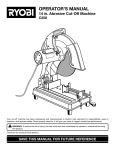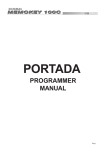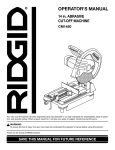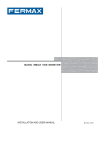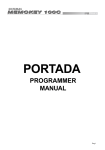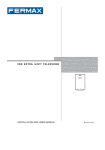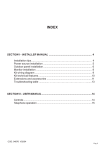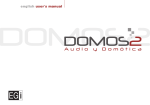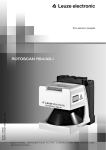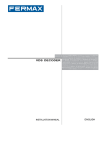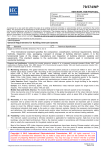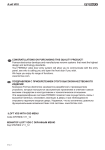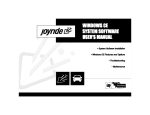Download 97528I (Bea) Memokey NCity 100 codigos V04_13.indd
Transcript
100 CODE MEMOKEY 1 2 3 4 5 6 7 8 9 A 0 B cityline USER& INSTALLER’S MANUAL 1 2 3 4 5 6 7 8 9 A 0 B skyline ENGLISH Memokey Memokey KEYPAD MODULE TEST This kit is programmed at the factory with 3 default codes. The preprogrammed codes are different for each unit, therefore you are the only one to know them. You can use this codes to test the equipment operation as well. To test the code, dial the the one corresponding to the device you want to verify. CODE ACTION CODE 1 (*) OPEN THE DOOR CODE 2 (*) ACTIVATE THE AUXILIARY DEVICE (if any) CODE 3 (*) BOTH OPEN THE DOOR AND ACTIVATE THE AUXILIARY DEVICE (*) These codes are shown in a sticker in the back side of the panel controller. Code 97528I, V04_13 Technical publication of an informative nature published by FERMAX ELECTRONICA S.A.U. As part of its policy of constant improvement, FERMAX ELECTRONICA S.A.U. reserves the right to modify the content of this document and the characteristics of the products referred to in it at any time and without prior notice. Any modification will be reflected in subsequent editions of this document. ENGLISH Pag 2 Memokey Memokey PROGRAMMING MANUAL INDEX Introduction.... ........................................................... 4 Function Programming and Configuration .... ........ 6 Changing the Master Code....................................... 9 Establishing the User Code Length ......... ................10 Full Reset of All Codes .............................................12 Restoring Factory Settings ..... ................................13 Adding or Editing User Codes ..................................14 Deleting User Codes ................................................16 Allowing User Codes to be Changed ........................17 Changing the Free Access Code ..............................18 Activating/Deactivating the Free Access Button .......20 Enabling/Disabling the Exit Buttons (interior) ...........21 Timing Lock-Release Activat. Relays and Aux. Devices. ....................................................................22 Enabling the Auxiliary Output (AUX).........................24 Quick Programming Guide .............................. ........26 Technical Features ....................................................29 Wiring Diagram ..........................................................30 USER MANUAL INDEX Introduction.... ...........................................................31 Keypad Operation......................................................32 Pag 3 Memokey Memokey PROGRAMMING MANUAL Introduction The Memokey’s 100 codes are designed for keypad based access control, where we want each system user to have their own access code. System Features: - The Memokey has capacity for 100 different codes of variable length (between 4 and 6 digits). Entering one of the codes via the keypad activates a relay which activates the lock-release or another device. - The system does not allow user codes to be repeated. - To enter programming mode, you must enter a special code, known as the Master Code. - If this option is enabled, any user can modify their personal access code without knowing the Master code. -The system has an auxiliary output which supplies a maximum of 125mA to connect/activate another device (auxiliary relay, alarm ...) or a speaker, with the memokey itself generating an alarm tone. - It is equipped with 2 auxiliary inputs for the exit button. - Free Access Codes - Key Press Confirmation via an acoustic tone. Pag 4 Memokey Memokey The following sections in the Manual explain in detail the configuration and management of each of the system functions. Acoustic Tones and Signal Leds. The Memokey has a series of acoustic tones and leds which advise as to the system’s current status: Acoustic Tones: Each time an access code, programming code or configuration setting is entered the system emits a different tone depending on whether the data entered is correct or not: beep (x3) : correct moc : incorrect beep (1 second) : Lock Release Pag 5 Memokey Memokey Signal Leds: Has two leds, one red and one green. RED GREEN DEFINITION No Power 1 2 3 4 5 6 7 8 9 A 0 B Normal mode (awaiting access code entry, programming...). Device Powered Up. Opening Door Quick Flashes: Programming Mode Slow Flashes: Awaiting the new value for the selected function ( Led on Led off Leds flashing) PROGRAMMING AND CONFIGURATION Programming Mode allows you to modify the system’s different settings and configuration. Initially the system is programmed by default with a 4 digit code. As such the user codes and MASTER code are 4 digits in length. If you require greater security you can change the length to 5 or 6 digits. See the chapter on: “Establishing the User Code Length” Pag 6 Memokey Memokey 1) To enter programming mode (having been in normal mode), enter the Master Code (1480 by default). beep (x3) : 1 2 3 4 5 6 7 8 9 A 0 B The system emits “3 beeps” to advise we are in programming mode, and the green led flashes in quick sequence. 2) To configure each of the functions (in programming mode) enter the corresponding function code (for example: “A4” code length). Enter 1480 beep (x3) : 1 2 3 4 5 6 7 8 9 A 0 B Enter A4 At this point the system once again emits “3 beeps” to advise that the setting entered is correct, and the green led flashes in a slow sequence . 3) Then a new value is entered to be assigned to the function selected (for example: selecting a code of 6 digits in length). 1 2 3 4 5 6 7 8 9 A 0 B beep (x3) : Press 6 To exit Programing mode at any time, press B or allow 20 seconds to elapse without any activity. Pag 7 Memokey Memokey NOTES: Default Master Code: - 4 digit length: 1480 - 5 digit length: 14803 - 6 digit length: 148036 If for any reason we need to reset the master code, having forgotten the previous one (refer to the corresponding chapter: “Restoring Factory Settings”), this will be the master code established for this operation. Below are all the system functions and the configuration steps for each of these. Pag 8 Memokey Memokey Changing the Master Code (A0) The Master code is necessary to enter programming mode. The equipment is programmed with a default Master code in factory (1480 by default). The procedure to change it is the following: 1 Enter programming Code Master mode: (1480) Bip (3 x) 2 Enter the relevant option: A0 Bip (3 x) 3 Indicate the new Master code: New Master Code Bip (3 x) Example: New Master Access 1480 A0 1234 Code for Programming. 1234 NOTE: If you forget the Master code, you can reset it to the default code of 1480, as explained in the “Restoring the Master Code” section. A master code cannot be a user code and vice versa. Pag 9 Memokey Memokey Establishing the User and Master Code Length (A4) Initially the user codes are 4 digits in length, including the MASTER code. If you require greater security you can change the length to 5 or 6 digits. 1 Enter programming Code Master mode: (1480) Bip (3 x) 2 Enter the relevant option: A4 Bip (3 x) 3 Indicate the new length: 4, 5 or 6 Example : 6 Digit Access and Master Codes 1480 A4 6 Bip (3 x) NOTE: If once the user codes have been programmed their length is changed to include a greater number of digits, additional zeros will be added to the existent codes to bring them in line with the new length. e.g.: User Code: - 4 digits: 1234 => select a greater nº of digits. For example: 6 - 6 digits: 123400Code. Pag 10 Memokey Memokey If once the user codes have been programmed their length is changed to include a fewer number of digits, the existent codes will have the last digits removed to bring them in line with the new length. e.g. User Code: - 6 digits: 123456 => select a fewer nº of digits. For example: 4 - 4 digits: 1234 If additional digits are to be re-added to the existing codes, the original digits will automatically be re-added. e.g. User Code: - 4 digits: 1234 => select a greater nº of digits. For example: 6 - 6 digits: 123456 Each time the code length is changed, the existing codes should be reset to avoid the codes being deleted or overwritten. The configuration of “code length” should be done before setting up the codes on the system. This will also effect the MASTER Code and the Free Access Code. Pag 11 Memokey Memokey Default Master Code: - 4 digit length: 1480 - 5 digit length: 14803 - 6 digit length: 148036 Default Free Access (trade) Code : - 4 digit length: 1593 - 5 digit length: 15935 - 6 digit length: 159357 If for any reason we need to reset any of these codes, having forgotten the previous one (refer to the corresponding chapter: “Restoring Factory Settings”), these are the codes that will be set on undertaking the operation in line with the code length established on the system. Full Code Reset (A9) This operation allows deletion of all existing access codes in the system’s memory. Pag 12 Memokey Memokey 1 Enter programming Code Master mode (1480) Bip (3 x) 2 Enter the relevant option: Bip (3 x) A9 3 Re-enter the master code (set by default as 1480) to confirm 1480 Bip (3 x) all codes have been deleted. Example : Reset all existing ac- 1480 A9 1480 cess codes. NOTE: Resetting is an irreversible operation, whereby any previously stored codes cannot be recovered. Restoring Factory Settings Resetting the Master and Free Access/Trade Code (where you have forgotten the previous one) This operation is carried out by electrically modifying the equipment, in the aim of ensuring it is impossible for anyone without physical access to the equipment to modify it in any way. Pag 13 Memokey Memokey 1. Disconnect the system’s power supply. 2. Short-circuit the “S2” and the system. If the system is equipped with a PI exit button, just press and hold it down (refer to the installation diagram). 3. Reconnect the system’s power supply and remove the short-circuit (or release the exit button) within 5 seconds. 4. If the process has been carried out correctly a double “beep” will sound and the green light will stay on. Next enter the following code A708B9. A double “beep” will sound and the system will reset itself, restoring its factory settings. NOTE: The restoration of default factory settings does not delete the rest of the information programmed on the system. Add or Edit User Codes (00 .....99) The codes are stored in the memory in sequence: position - code - action. Allows up to 100 access codes be stored. Pag 14 Memokey Memokey 1 Enter programming mode: Code Master (1480) Bip (3 x) 2 Enter the position in the access code’s memory: 00...99 Bip (3 x) New Access Code Bip (3 x) 3 Re-enter the new access code: (The code length must coincide with that established on the system). 4 Enter the associated action: 1: The door will open. (Relay 1) 2: The auxiliary device will be activated (if exists). (Relay 2) 3: The door will open and the auxiliary device will be activated simultaneously. 1, 2 or 3 Bip (3 x) Example: New access code 1111 saved in the 1480 00 1111 1 00 position. Pag 15 Memokey Memokey NOTES: If the position to be recorded is already in use, the new code will replace the old one. If the code entered already exists you cannot record and an error message will sound. It is very important that a list is prepared of the codes, their positions and actions. Deleting User Codes (AA) It is possible to delete a specific user code. The procedure to follow is the following: Pag 16 1 Enter programming Code Master mode: (1480) Bip (3 x) 2 Enter the relevant option: AA Bip (3 x) 3 Enter the position of the access code to be deleted in the system’s memory: 00...99 Example: Delete the access code saved in the 00 position. 1480 AA 00 Bip (3 x) Memokey Memokey NOTES: It is only possible to delete a code if the associated position is known, based on which we reiterate the importance of keeping a list with the position data, codes and actions programmed on the system. Deleting a code is irreversible, such that once a code has been deleted it cannot be recovered. Allows user codes to be changed by users themselves (A7) Users can change their assigned access code for another code of their choice if they wish. To do this the following option must be enabled. 1 Enter programming Code Master mode: (1480) Bip (3 x) 2 Enter the relevant option: A7 Bip (3 x) Example: Allows users change their personal access code 1480 A7 NOTE: See the User Manual Section. Pag 17 Memokey Memokey Changing the Free Access Code (A1) There is a special “free access” code (initially this code is: “1593”) which allows free access via an additional button. It has an associated default relay which activates the lockrelease. This function is especially useful when you want to offer free access to an area to be controlled. Entering the “free access” code, (by default 1593), the button remains enabled until this code is re-entered at which point it will be disabled. Pag 18 1 Enter programming mode: Code Master (1480) Bip (3 x) 2 Enter the relevant option: A1 Bip (3 x) 3 Enter the Free Access Code: New Free Access Code Bip (3 x) Memokey Memokey 4 Enter the associated action: 1:The door will open. (Relay 1). 2:The auxiliary device 1, 2 or 3 will be activated (if Bip (3 x) exists). (Relay 2). 3: The door will open and the auxiliary device will be activated simultaneously. Example :Create a Free Access Code: 5251 to 1480 A1 5251 1 open the door. NOTE: The default free access (trade) code based on the number of digits will be: - 4 digit length: 1593 - 5 digit length: 15935 - 6 digit length: 159357 Pag 19 Memokey Memokey Activate/Deactivate the Free Access Button Entering the “free access” code, (by default 1593), the button remains enabled until this code is re-entered at which point it will be disabled. 1 Enter the “free access” code (1593 by default) Free Access Code (1593) Bip (3 x) 2 Button Enabled Example: Enable the “free access” button. 4 Re-enter the “free access” code (1593 by default) 1593 Free Access Code (1593) 5 Button Disabled. Example: Disable the “free access” button. Pag 20 1593 Bip (3 x) Memokey Memokey Enabling/Disabling the Exit Buttons (A5 - A6) The system can be equipped with one or two buttons (P1 and P2) which are installed in the interior of the building and allow you to open the door (relay activation) from inside or activate an additional electronic device installed. These buttons can be enabled or disabled in the following way: 1 Enter programming mode: Code Master (1480) 2 Enter the relevant option: A5: 1 Button. (Relay 1) A6: 2 Button. (Relay 2) A5 or A6 Bip (3 x) Bip (3 x) Pag 21 Memokey Memokey 3 Enter the associated action:. 0: Button Disabled. 1: Button Enabled. Action, the door will open. (Relay 1) 2: Button Enabled. Action, the auxiliary device will be 0, 1, 2 or 3 activated (if exists). (Relay 2) 3: Button Enabled. Action, the door will open and the auxiliary device will be activated simultaneously. Bip (3 x) Example : Enable exit button 1480 A5 1 1 to open the door. Relay Timing: - lock-release activation (A2) - auxiliary device activation (A3) Initially the relays (which will activate the lock-release or the auxiliary device) are set at 3 seconds. The activation time can be changed to any value between 00 and 99 seconds or it can also operate in bistable mode (the first valid code activates the relay and the next one deactivates it): Pag 22 Memokey Memokey 1 Enter programming Code Master mode: (1480) 2 Enter the relevant option: A2 Relay 1 (lock-release) A3: Relay 2 (additional electrical device activation) A2 or A3 Bip (3 x) Bip (3 x) 00: 3 Enter the new activation Bistable Mode code or select bistable 01..99: Bip mode: (01 to 99 se- (3 x) conds 4 Enter 1 if the device is normally deactivated. Enter 0 if the device is normally activated. 1 or 0 Bip (3 x) Example: Change the relay timing to 5 seconds and 1480 A2 05 0 normally deactivated. NOTE: The most common case is that of normally deactivated devices such as normal lock-releases for example. The inversely operated lock-releases on the other hand are normally activated devices. Pag 23 Memokey Memokey Enabling the Auxiliary Output (all-purpose device) - AUX (A8) This equipment has a free contact auxiliary output which can be connected to a 12 Vdc device with a maximum current of 125 mA to carry out various functions. Where the equipment to be connected does not adjust to these specifications, a relay should be used (Ref. 2013). Pag 24 1 Enter programming mode: Code Master (1480) 2 Enter the relevant option: A8 Bip (3 x) Bip (3 x) Memokey Memokey 3 Select the option you require: 0: The all purpose output is not used (by default). The auxiliary output remains deactivated. 1: Each time a valid code is entered a 1 second pulse will be generated. 2: Every time Relay 1 is activated the allpurpose device will also activate, and will remain activated for 5 seconds longer than the associated device. 3: The all purpose output will switch every Bip time a valid code is entered. 4: The all purpose output will be activated (3 x) and will remain active every time you press “A” and a valid keypad code, (purpose output will remain during 1 minute active). 5: The all purpose output activates once 5 erroneous codes are entered in order, and will remain active for 5 minutes or until a valid code is entered. 6: The all purpose output activates once any key is pressed or deactivates after 15 seconds with inactivity. Example: Enable auxiliary output. 1480 A8 1 Pag 25 Memokey Memokey GUIDE RAPIDE DE PROGRAMMATION Function Code AA A0 Activation and Assignment of Access Codes (100 codes). Code Deactivation. Master Code Programming. A1 Programming the Free Access (trades) Code. 00...99 A2 A3 A4 A5 A6 A7 Pag 26 Function Description Programming the Relay Activation Time. (Relay 1) Programming the Auxiliary Device Time. (Relay 2) Changing the code length from 4 to 6 figures. Enabling/Disabling the P1 lock-release exit button.(Relay 1) Enabling/Disabling the P2 auxiliary device button. (Relay 2) Enabling/Disabling the option for users to change their code. A8 All-Purpose Device Auxiliary Output Configuration (which is called “AUX”). A9 Delete all Codes. Memokey Memokey Sequence of codes to be entered: Code Master (1480) + Example 00...99 Memory Position AA A0 A1 A2/A3 A4 Access Code (4 to 6 + digits) + associated 1480 02 1144 1 action (1, 2 or 3). 00...99: Memory Posi+ tion of the Code to be Deleted . + New Master Code New Free Access + Code: 00: Bistable Mode + 01..99 (01 to 99 seconds) + 4, 5 or 6 1480 AA 02 1480 A0 1234 1480 A2 00 0 1480 A2 05 1 1480 A4 6 Pag 27 Memokey Memokey Sequence of codes to be entered: Code Master (1480) + Example 0: Button Disabled. A5/ + A6 A7 + A8 + A9 + Pag 28 1480 A5 0 1: Button Enabled. Lock Release. 1480 A5 1 (Relay 1) 2: Button Enabled. Activate auxi1480 A5 2 liary devices. (Relay 2) 3: Button Enabled. Activate door 1480 A5 3 + auxiliary device simultaneously Allowing User Codes to be Chan1480 A7 ged All-Purpose Device Auxiliary Output Configuration (0, 1, 2, 3, 4, 5 1480 A8 1 or 6). Code Master (1480) 1480 A9 1480 Memokey Memokey TECHNICAL FEATURES Power Supply: 12 Vdc/Vac. Operating Temperature: -20º to 55º C. Capacity: 100 Access Codes Non-Volatile Memory. Consumption: * On standby: 40 mA * With the lock-release relay active: 110 mA Panel Connectors: +, -: 12 Vdc Power Supply. C1, R1: relay output 1 (potential free) - C1: relay 1 common wire (lock-release). - R1: Normally open (NA) or normally closed (NC) contact (based on configuration). C2, R2: relay output 2 (potential free) - C2: relay 2 common wire (lock-release). - R2: Normally open (NA) or normally closed (NC) contact (based on configuration). A: auxiliary/panic output. Collector Output Open. Maximum current of 125 mA Pag 29 Memokey Memokey CABLING DIAGRAM MÓDULO MEMOKEY MEMOKEY MODULE MODULE MEMOKEY MEMOKEYMODUL UP PAL 12V C1 R1 TRADE S1 - S2 C2 R2 A C1 R1S1 - S2 C2R2 A ALL-PURPOSE DEVICE AUXILIARY OUTPUT PI2 PI1 Vac POWER SUPPLY 12 Vac /12 Vdc LOCK-RELEASES 12 Vac / 12 Vdc Memokey Connections: PI1-Output Button (S1,-): Button to open the door from inside. PI2-Exit Button (S2,-): Auxiliary Electronic Device Activation Button. PAL-Free Access Button (TRADE): Optional button to allow free access to the building. Notes: The operating parameters for the free access, auxiliary exit (all purpose) and lockrelease buttons are configurable. Use a lock-release suitable for the power supply you are going to use (Vac or Vdc). Pag 30 Memokey Memokey USER MANUAL Introduction This equipment includes a keypad which allows the door be opened in addition to the activation of an auxiliary electronic device on entering a personalised code. It is possible to programme up to 100 different personalised codes. Generally one of these codes is given to each of the system users, taking users to be not just the people that frequently access the residence or the area, but also those who will be granted access in the future (for example in the case of offices). In the case of personalised codes, we can prohibit the use of any code by a specific user just by deleting the code from the system. Management of all these personalised codes (activation, deactivation, etc) is done by the system administrator. NOTES: The SYSTEM ADMINISTRATION can assign a personal code for opening the door and/or activate auxiliary devices for any of the authorised users. Users can change their personal code if this option has been enabled by the SYSTEM ADMINISTRATOR. The system has anti-sabotage protection, such that once 5 erroneous codes have been entered on the keypad it will remain locked for 30 seconds, emitting a warning tone Pag 31 throughout this period. Memokey Memokey Keypad Operation • Code: Code to be entered using the keypad to activate the lock-release. • Emergencies: Opens the door and generates an alarm tone (where this option has been configured). • Free Access: Entering this code the door will remain open until the free access code is re-entered. • Changing the Code: Users can change their own personal code if this option has been enabled by the SYSTEM ADMINISTRATOR. Pag 32 Memokey Memokey User:__________________________________________________ Code: _____________ Emergencies (*): ‘A’ + CODE Free Access (*): _____________ Change Code (*): ‘AB’ + CODE to be changed + NEW (*) This option should be enabled. Contact the system administrator. Cut out and deliver a copy of this section to each of the users. Pag 33 Memokey Memokey Pag 34 Memokey Memokey Pag 35




































